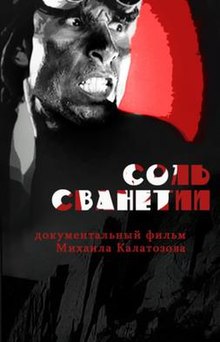Salt for Svanetia
| Salt for Svanetia | |
|---|---|
 |
|
| Directed by | Mikhail Kalatozov |
| Written by |
Sergei Tretyakov Mikhail Kalatozov |
| Cinematography | Shalva Gegelashvili Mikhail Kalatozov |
| Edited by | Viktor Shklovsky |
| Distributed by | Gruziya-film |
|
Release date
|
Produced in 1930, Premiere in November 1931 |
|
Running time
|
55 min |
| Country | Georgian SSR, Soviet Union |
| Language | Silent film |
Salt for Svanetia (Georgian: მარილი სვანეთს, Russian: Соль Сванетии) is a 1930 SovietGeorgian silent documentary film directed by Mikhail Kalatozov. As one of the earliest ethnographic films, it documents the life of the Svan people in the isolated mountain village of Ushguli in Svanetia, in the northwestern part of the Georgian Soviet Republic. Containing some propaganda, the climax of the film shows how a Soviet built road connects the previously isolated mountain village to Soviet civilisation. Many of the scenes of the film were staged, and the authenticity of some scenes has been disputed by the Svan people.
Most of Salt for Svanetia describes and explores the daily life of the Svan people, who are living isolated from civilisation in a harsh natural environment in the mountainous region of Svanetia. The film starts with the Lenin quotation "Even now there are far reaches of the Soviet Union where the patriarchal way of life persists along with remnants of the clan system." Svanetia and the mountain village of Ushguli are then located on two slowly dissolving maps of the region and are described as "cut off from civilization by mountains and glaciers". The location of the village is further introduced by several expository shots showing the Svanetian landscape. These shots give some emphasis to tall towers (still visible in the 2006 photograph below). It explains that these have been constructed by villagers to serve as a defense against feudal overseers, and it shows how villagers have used them to fend off tax collectors by heaving rocks from the tower tops. This introductory focus on class conflict fades as the film moves to concentrate on the daily routine of the villagers. One sequence shows how sheep are raised, another how wool and yarn are produced, and another on how barley is threshed. These sequences powerfully convey the technological underdevelopment of the area. Wool spinning technique antedates the spinning wheel; barley is threshed by cattle dragging a stone studded platform, weighed down by a mother tending to her child, over the barley. Another scene shows a suspension bridge and a man trying to cross over rushing water as his pack animals resist. A desperate harvest during an early July snowstorm is shown. Other scenes show how the Svan people tailor their clothes, make hats, cut their hair and bury their dead.
...
Wikipedia
